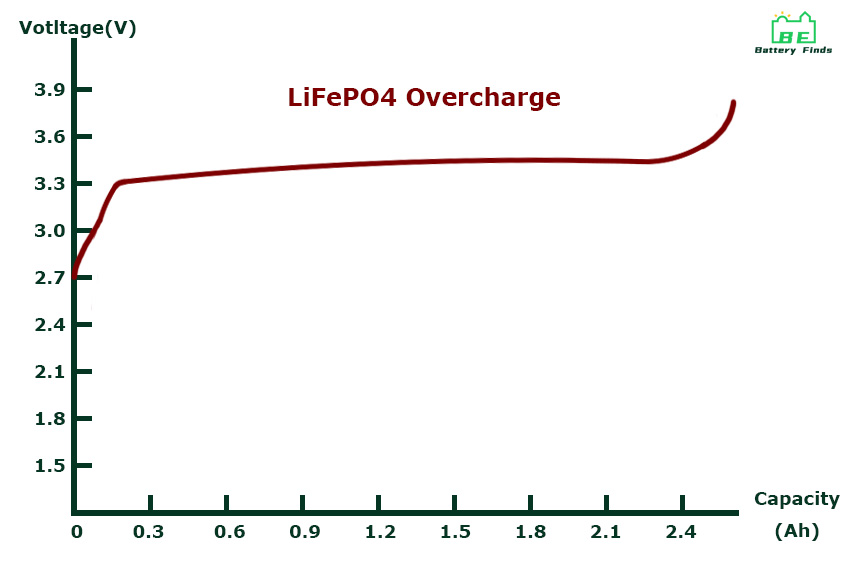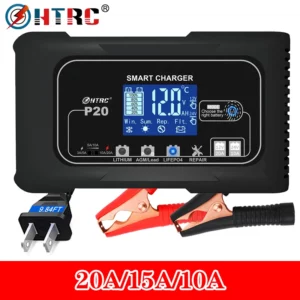LiFePO4 over-discharge and LiFePO4 overcharge are the two most harmful operations of LiFePO4 batteries. There is no doubt that these two operations will directly damage the structure of the battery itself, greatly shortening the battery life and performance. So, the correct LiFePO4 battery charging is crucial.
LiFePO4 Over-discharge

LiFePO4 over-discharge is one of the most common man-made faults in LiFePO4 batteries, which refers to the process in which the internal power of the battery has been completely consumed, but continues to discharge under the action of voltage. Over-discharge will cause copper dendrites, resulting in a short circuit of the battery, increased internal resistance, reduced capacity, and shortened life.
LiFePO4 over-discharge is something we can avoid. We need to use suitable equipment to protect the battery, such as the most common BMS, or the less expensive PCM and PCB. This device can ensure that the battery is prevented from abnormal voltage when it reaches the discharge limit (LiFePO4 batteries generally recommend 80% DOD discharge), thereby ensuring that the battery will not discharge endlessly. In addition, it is highly not recommended to fully discharge the LiFePO4 battery to prevent the possibility of over-discharge from the root cause.
If LiFePO4 over-discharge has occurred, is there any room for recovery? In fact, it can only be partially recovered. You can use the parallel charging board to connect to the normal 3.2V LiFePO4 battery for charging and repair it in time. However, it should be noted that this method of recovery is only applicable to LiFePO4 batteries whose voltage is still around 3V after over-discharge, and LiFePO4 batteries with too low voltage are dead and cannot be saved. It is worth mentioning that because over-discharge damages the active material in the battery, which means that the damage caused is almost irreversible, it is more important to prevent over-discharge than to deal with it.
LiFePO4 Overcharge

LiFePO4 Overcharge is also a big problem. Overcharge refers to the possibility that the voltage given by the charger to the LiFePO4 battery is higher than the normal charging voltage of the LiFePO4 battery, resulting in battery damage. Generally speaking, the charging voltage of a single LiFePO4 cell is 3.65V, and if the voltage given by the charger is higher than 3.65V, it will cause overcharge. Overcharging will cause lithium dendrites, that is, a large number of lithium ions overflow from the positive electrode, and the lithium ions that cannot be absorbed by the negative electrode will form dendrites on the surface of the battery, resulting in a short circuit inside the battery. The short circuit will generate a lot of heat, and in severe cases, it will also cause the decomposition reaction of the positive electrode or the reaction between the negative electrode and the electrolyte. As a result, the performance of the LiFePO4 battery drops sharply.
Similarly, LiFePO4 overcharge can also be avoided. First of all, it is necessary to use the most suitable charger. At present, many customers are upgrading from lead-acid batteries (such as AGM batteries) to LiFePO4 batteries. The chargers used in lead-acid batteries can of course be LiFePO4 batteries to some extent. The battery charges, but lead-acid battery chargers have lower voltages, which means LiFePO4 batteries cannot be fully charged, which affects performance. Also don’t use a charger that provides too high a voltage, which will undoubtedly damage your LiFePO4 battery, and there is a high probability that the LiFePO4 battery will be swollen, which will significantly affect performance. Secondly, it is still necessary to install BMS, or circuit protection devices such as PCM and PCB, which can fully prevent your battery from being overcharged. When the abnormal battery voltage is detected, it will automatically cut off the charging to ensure that the battery is not protected from damage. In addition, LiFePO4 overcharge cannot be repaired, only through prevention.
To prevent such damaging scenarios, the HTRC P20 20A LiFePO4 Smart Battery Charger is an essential tool for your battery maintenance arsenal. This advanced charger is designed specifically for LiFePO4 batteries, ensuring they are charged safely and efficiently.
Product Features of HTRC P20 20A Charger:
Charge Current Switch: Allows for the selection of charging modes suitable for 12V or 24V Lithium batteries, including LiFePO4.
BMS Compatibility: Tailored for use with batteries equipped with Battery Management Systems, ensuring optimal charging performance and protection.
Activation and Maintenance: Ideal for rejuvenating weak, old, or idle batteries, helping to restore their performance.
Safety First: Equipped with multiple safety features including over current, over-voltage, short circuit, and reverse connection protection, this charger is designed to prevent damage to your battery and ensure safe charging.
Why Choose HTRC P20 20A Charger?
Intelligent Charging: The charger’s CPU intelligently monitors the charging process, automatically entering trickle charging mode once the battery is full. It also features the latest pulse repair function to help restore lost battery performance.
Wide Application: Suitable for a variety of vehicles and equipment, from cars and trucks to motorcycles, SUVs, golf carts, and more.
User-Friendly: With a large LCD display, it’s easy to monitor the charging status, voltage, current, and other vital information. The simple operation procedure makes it a breeze to use.
The HTRC P20 20A Charger is not just a charger; it’s a battery protector, designed to extend the life of your LiFePO4 batteries and provide you with reliable, safe, and efficient charging. Invest in the HTRC P20 today and ensure your batteries are always ready for your power needs.
Summary
There is no doubt that both LiFePO4 over-discharge and LiFePO4 overcharge will seriously affect the battery performance. Compared with over-discharge and overcharge, prevention is a more important step, and BMS is the most recommend. Treatment can only be remedial rather than repair, but it will not make the performance of the battery drop too seriously, and prevention can fundamentally eliminate the battery. The means of over-discharge and over-charge can make LiFePO4 batteries provide us with safer, longer-lasting, and better-quality power assistance.



Ya , ya think maybe you could write an article how to Recover from an over and undercharged LFP.
I know the BMS will cut off at both points eventually.
But where do we go from there ?
Thank you
Jeff
Unfortunately, you buy a new one. Once the chemistry is deeply discharged the cell/battery has likely failed. Although, if caught early enough some capacity may be recovered. However, full battery life will be depreciated.
Recovery may be accomplished by charging at a C/10 rate or less over a series of short sessions which help to avoid internal heating and attempts to clear any dendrites that may be shorting. Then incrementally increase the charge rate and repeat the process. If the battery is salvageable it will eventually charge to near total capacity. If the battery makes it to this point run through a few full charge/discharge cycles allowing time for the battery to completely cool to room temp internally. Do not discharge below the manufacturer’s specified low battery cut off point. Expect the entire process to take a couple of days.
There is no guarantee the process will restore an over discharged LFP and if the application is critical, replace the battery.
Thank you for providing the instructions to recover an over-discharged battery. Yeah,Just as you said, it’s important to note that there is no guarantee this process will restore an over-discharged lithium iron phosphate (LFP) battery. If the battery is critical for an important application, it may be advisable to replace the battery rather than attempting recovery.